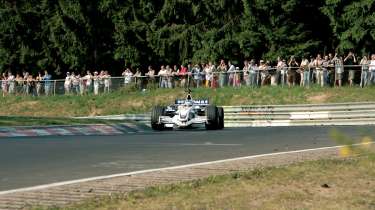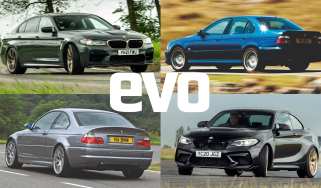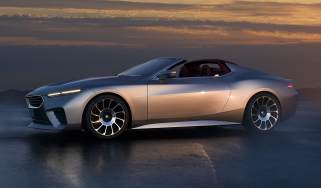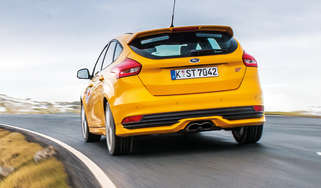News feature: BMW F1 at the Ring: Faszination
The Nordschleife hadn’t seen a modern F1 car in over 30 years. Then Nick Heidfeld arrived in his BMW Sauber F1.06…
The prospect was tantalising: a modern F1 car on the biggest, baddest Grand Prix circuit of them all. Unfortunately the reality was somewhat neutered, both by too-good-to-miss marketing opportunities and the too-risky-to-contemplate dangers of a full-on brain-out lap-record attempt.
Still, in an age when race teams predict, test, simulate and analyse-out every possible eventuality and surprise, BMW Sauber’s 'let’s crank the ride height up and see what happens' approach to Nick Heidfeld’s historic trio of laps around the Nürburgring Nordschleife was unexpectedly inspiring.
In typical modern-day F1 fashion, BMW’s press schedule meant that to get any time with Nick for pre- and post-lap sound-bites you had to loiter in the pitlane of the adjoining modern GP circuit and watch the momentous event on a monitor. Consequently you’ll find this story rather light on snippets from ‘Quick Nick’, as photographer David Shepherd and I ignored press protocol and legged it to Brünnchen and Wippermann for a proper point-blank view of 21st century F1 on a resolutely 20th century circuit. I hope you understand.
Out in the forest the crowds are heaving. There was a four-hour VLN endurance race earlier in the day, but where you’d normally see queues of traffic filing out, endless streams of cars are jostling to get in. With half an hour to go before the Nordschleife quivers to the sound of a modern-day F1 V8 at 19,000rpm, every scrap of parking area, roadside verge, farmer’s field and forest track is jammed.
There’s a buzz of anticipation. People fidget and crane for the best vantage point. Small transistor radios fizz and crackle with the voice of a German commentator. All around, the skrrch of Bitburger cans being opened punctuates the eerie silence as fans fight the unseasonable heat with high-strength pilsner.
Then, like an approaching storm, it comes. A distant, animalistic whoop from deep in the forest, then a longer, drawn-out scream as the BMW Sauber relentlessly hauls its way up towards Bergwerk, where Niki Lauda was engulfed in flames and the gnarly old Nürburgring lost its F1 future.
Up the long climb it brays, through the blind crests and kinks, until the tortured V8 shriek finally reaches an aural plateau then subsides as Heidfeld waits – waits! – for the chase helicopter to catch him and get the marketing money-shot: his BMW Sauber edging around the rim of the iconic Karussell.
Beyond the concrete saucer is Hohe Acht, the Nordschleife’s summit. We’re tucked in its lea, with a perfect view of the track as it tumbles down through Wippermann. We still can’t see it, but the car is so loud, so close, it seems hard to believe it’s not upon us. Surely we haven’t missed it? Louder, louder, louder. So loud it almost feels like heat on your skin. Then, in a flash of white and blue, it’s in our faces, the frantic soundtrack somehow not quite matching the speed of the car. It’s quick – quick enough to trigger cheers and shouts – but somehow it’s not the searing spectacle our collective fevered imagination had promised.
Next time around, Nick’s pushing harder, throttle inputs more insistent, the car’s body language more aggressive. The helicopter pilot’s pressing on too, tipping into the turns, rotor blades slapping the air like the soundtrack from a Vietnam War movie. Below, the BMW Sauber is starting to dance, the air above the exhaust chimneys bending and creasing with the heat, dust and detritus from the VLN race being sucked into the diffuser’s vortex and flung skywards. It looks at home.
No one’s quite sure how many laps to expect, but three seems reasonable. So third time around I make sure I watch the car shimmy over Eschbach and out of sight, savouring the sound long after the vision has faded.
There’s a good few inches of fresh air between the tarmac and the car’s usually ground-skimming underbelly. Later we learn that, in addition to winding in an additional 6cm of ground clearance, the BMW Sauber was running Monaco gearing and barn-door wing settings. I’m not one for conspiracy theories, and I know the mild-mannered and unfashionably hirsute Heidfeld isn’t your typical F1 headcase, but as anyone who saw him nail the Goodwood Festival of Speed hillclimb record in 1999 will know, he’s not called Quick Nick for nothing. Strap him into a car fitted with Monza settings and send him out onto a deserted Nordschleife and there’s no question he’d have gone for it. And the results would have been spectacular. Or deadly.
And that, I guess, is the point. Today’s F1 cars aren’t built for the Nordschleife. But then yesterday’s F1 cars weren’t built to race on the Nordschleife either, but the drivers did it anyway. In those days they approached their trade with courage and pragmatism. Accidents happened to other people, at least that’s what they told themselves. But in the darkest, most tightly closed recesses of their minds they also knew that if they did have an accident, the chances were it wasn’t going to be pretty.
Today Niki Lauda looks back on his qualifying efforts for the 1975 German Grand Prix and says, very matter of factly, that his 6min 58sec effort was down to one overriding factor: he wasn’t afraid to die. No one expects today’s F1 drivers to make such a chilling commitment to their sport – we want heroes, not martyrs – but despite the hobbling effects of a deliberately compromised set-up and having to fulfil photographic duties, through those sections where it was running free, it was a breath of fresh air to see an F1 car in an environment that imposed a set of unwritten rules all of its own.
For three blissful laps only Nick Heidfeld knew how much he and his car had in reserve. For three blissful laps he was feeling his way around, relying on instinct and reflex rather than test-team analysis and feedback. For three blissful laps we stood and watched an F1 car driving on a circuit where the driver, not data, did, would, could so clearly make a difference. We watched, and it felt good.





